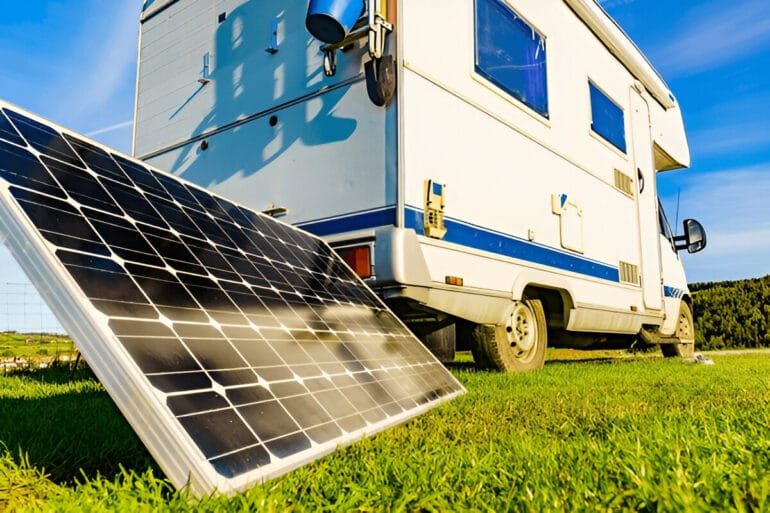In recent years, the demand for solar power panels on the move has grown geometrically, particularly in sunnier parts of the world like Australia. As Australians seek cleaner alternatives and on-the-go energy solutions, use of portable solar panel technology has pervaded more than ever. From exploring the outback to beach camping or preparing yourself for off-grid emergencies, portable camping solar panels and other mobile uses provide an independent, eco-friendly source of power.
This whole guide will delve extensively into portable solar power panels, their parts, advantages, operation, and reasons why individuals in Australia are going solar, as well as information on the solar energy rebate NSW and how to select the most appropriate portable solar panels for your requirement.
What Are Portable Solar Power Panels?
Solar power portable panels are light, compact solar power systems that are convenient to take along and mount anywhere sunlight is accessible. Solar panel portable kits differ from fixed and permanently mounted roof solar systems since they are foldable, driven in automobiles, or even mounted in backpacks.
These panels use the energy of the sun through photovoltaic (PV) cells—the most prevalent being crystalline silicon in composition—converting the energy of the sun into usable electricity. Perfect for road trips, camping, off-grid communities, caravanning, and outdoor excursions, portable panels mean a break from the sound of generators and intermittent grid supply.
How Do Portable Solar Panels Function?
The process of working for portable solar power panels is no different from roof panels:
- Sunlight Capture: Solar cells trap sunlight (made up of energy particles called photons).
- Electric Field Generation: The generated electric field by the silicon cells causes electrons to move, generating direct current (DC) electricity.
- Charge Control: A charge controller controls energy flow, avoiding overcharging of the battery.
- Energy Storage: Energy is stored in a battery for later use.
- Power Conversion: An inverter converts stored DC power to alternating current (AC) electricity for powering appliances.
For small applications like lighting, charging a phone, or running small appliances, this off-grid system is not only efficient but also sustainable.
Parts of a Portable Solar Panel System
A standard solar panel portable kit includes:
- Solar Panels (foldable or suitcase-style)
- Charge Controller
- Battery Pack (deep-cycle lead-acid or lithium-ion)
- Inverter
- Adapter Kits and Cables
- Storage Case and Mounts
The modules are modular and come in various capacities—from 60W to 320W and higher—depending on your needs for consumption.
Portable Solar Panel Types
Portable panels come in various forms for meeting various power needs:
- Folding Solar Panel Kits: The most popular for portable solar panels for camping, these are conceived in the form of a suitcase for ease of portability.
- Flexible Solar Panels: Made with light material and ideal for curved surfaces.
- Briefcase Panels: Stronger, generally higher watt capacity.
Selecting the most suitable portable solar panels involves issues such as durability, weight, wattage, weatherproof, and portability.
Where Portable Solar Panels Are Used
The extensive and diverse geography of Australia makes it a prime location for portable solar power panels. Typical applications are:
- Camping and Caravanning: Provide power for lighting, fans, cooking appliances, and charging points where the grid is unavailable.
- Boondocking and Off-Grid Living: These systems in the remote location provide trustworthy electricity.
- Emergency Backup: For remote workplace locations and power outages.
- Outdoor Activities and Events: From picnics to festivals, portable panels provide short-term power solutions.
Portable Solar Power Panel Benefits

- Green Energy Source
Portable solar power panels significantly minimize the use of fossil fuels. Solar has no emissions and is totally silent—perfect for outdoor occasions.
- Portability and Flexibility
Light and portable, they are easy to carry and set up anywhere. From camping at Byron Bay to hiking in the Flinders Ranges, they’re an anywhere option.
- Cost-Effective
Solar panel portable kits, once purchased, cost very little to run. Sunshine is free, and minimal maintenance needs are often limited to wiping over panel surfaces.
- Off-Grid Capability
With an inverter and battery pack, you can save energy during the daytime to use at night or on cloudy days—perfect for backcountry or emergency travel.
Things to Consider
Although flexible, portable solar panels have some disadvantages:
- Limited Power Output: They’re often too small to power heavy loads such as refrigerators or air conditioners.
- Weather Dependency: Shaded or cloudy weather reduces their output.
- Initial Investment: While cheaper than installations on the roof, high-quality kits also demand a significant initial investment.
Solar Energy Rebate NSW and Government Support
If you reside in New South Wales, the solar rebate NSW provides financial incentives for using solar energy solutions. Though rebates are mostly provided to residential and commercial systems, consumers who buy portable solar power panels indirectly benefit as well—like reduced GST on environmentally friendly products or possible rebates for solar batteries when bought in combination.
These government-backed programs encourage a cleaner energy future and bring solar energy within reach of more average Australians.
Best Portable Solar Panels: What to Consider
Selecting the best portable solar panels means considering a few important factors:
- Wattage Rating: Describes how much power it will produce.
- Weight and Size: Important factors when it comes to portability.
- Durability: Panels must be weather-resistant and long-lasting.
- Efficiency: Greater efficiency equals stronger performance in poor light.
- Battery Compatibility: Your system must save energy efficiently.
- Warranty: A good warranty ensures durability.
Practical Tips for Portable Solar Panel Use
For Optimal Output and Long Life:
- Place Panels Where They’ll Receive Most Sun: Direct sunlight = highest efficiency.
- Clean Panels Regularly: Dust and dirt can disrupt absorption.
- Avoid Overloading the Inverter: Know your system’s capacity.
- Store Safely: Out of commission, store panels in their case and dry.
How to Install a Portable Solar System
Just follow these basic instructions:
- Calculate Power Needs: Sum the wattage of all your equipment.
- Select Configuration: Series (greater voltage) or parallel (greater current).
- Install Charge Controller: Safeguard your batteries.
- Connect to Battery: Charge your battery with efficiency.
- Plug into Inverter: Convert to AC power and operate your equipment.
In plug-and-play configurations, simply install the panels, plug into the battery, and charge your devices immediately.
Who Should Use Portable Solar Panels?
- Campers and Outdoor Adventurers
- Remote Workers and Digital Nomads
- Emergency Preppers
- Vanlife and Tiny Home Residents
- Eco-Conscious Consumers
Real-Life Illustration: Why Australians Adore Portable Panels
Australia is home to some of the most stunning and remote travel destinations in the world—and one such beloved spot is Margaret River in Western Australia. Known for its rolling vineyards, scenic coastline, and outdoor adventure opportunities, Margaret River is a haven for campers and nature lovers. But in places like this, access to grid electricity can often be limited or entirely unavailable, especially at unpowered campsites nestled in nature.
This is where camping portable solar panels really come into their own.
Picture loading up your caravan or 4WD and driving to a secluded camp site along the river. Rather than having to seek out a powered camp site or using a loud petrol-driven generator, you lay out your compact, suitcase-type portable solar power panels. These can be configured in mere minutes—no fiddly installation or background noise required.
As the morning sun rises, the portable panels start absorbing sunlight, quietly turning it into useful electricity. They power your solar power station or battery throughout the day, reserving energy for when you need it most—such as in the evening when it gets chilly and you’d like to turn on some LED lights, run a fan, charge your mobile, or even cook supper using a small electric cooking stove.
Thanks to this trustworthy and renewable configuration, your whole experience is off-grid and stress-free. No generator din to spoil the serenity of nature sounds. No fuel odor. No fear of petrol running out or damaging the environment. Just tidy, quiet power produced on the move.
This is a brilliant example of why Australians are adopting portable solar solutions than ever before. Whether you are out camping, traveling by road, or just spending time outdoors, these systems enable you to be independent and environmentally friendly at the same time. With Australia’s wide open spaces, sunny weather, and increasing demand for eco-friendly living, portable solar panels provide the perfect blend of freedom, affordability, and green consciousness.
Briefly, they let you be in nature and yet still have the comfort and convenience—and that’s the real beauty of solar-powered freedom.
Conclusion: Is It Worth Investing in Portable Solar Panels?
Definitely. For outdoor enthusiasts or those in need of reliable backup power, portable solar power panels are a great investment. Whether you’re pursuing sunsets along the Gold Coast or driving deep into the Outback, these portable solar systems allow you to go further with peace of mind.
Although they’re not a complete alternative to rooftop solar systems, portable solar panel kits provide value, sustainability, and autonomy.
For the transition to solar, Easy Solar is a known and respected brand in the Western Australian market. With decades of expertise in the solar industry, they provide:
- Economical solar installations for homes and businesses
- Personalized battery storage solutions
- Advice on the solar rebate NSW and funding
- Effective after-sales maintenance and warranty
Easy Solar makes the solar experience easy—from temporary arrangements to full-scale rooftop installations.
Get started today and harness the sun’s limitless energy.







